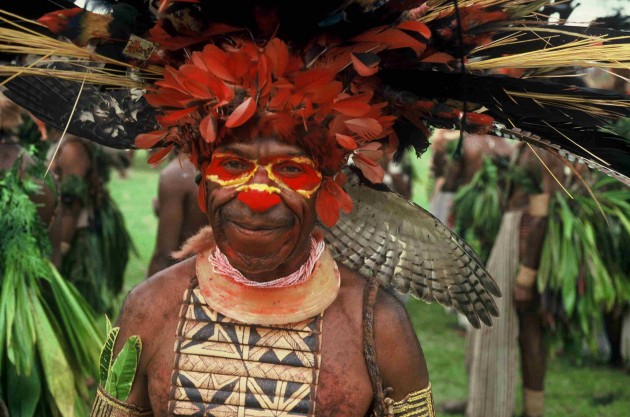
Huli Wigmen in line, New Guinea. (Photo: Bruce Beehler)
 The majestic feathers of the greater bird of paradise (Paradisaea apoda) have inspired people for thousands of years. Like many birds on the isolated island of New Guinea, these highly decorated creatures have evolved not only their unusual appearance but also unique relationships with indigenous communities.
The majestic feathers of the greater bird of paradise (Paradisaea apoda) have inspired people for thousands of years. Like many birds on the isolated island of New Guinea, these highly decorated creatures have evolved not only their unusual appearance but also unique relationships with indigenous communities.
To celebrate the publication of Birds of New Guinea, an essential field guide to the birds of the world’s second largest island, Smithsonian Science asks author Bruce Beehler what makes the birds of this region so remarkable. Beehler is research associate in the Division of Birds at the Smithsonian’s National Museum of Natural History, and Joshua A. Bell ethnology curator in the museum’s Department of Anthropology.
What makes the birds from this region so special?
Beehler: It’s earth history. New Guinea and Australia have been separated from other continents for over 100 million years. While at several points Australia and New Guinea were linked, there has never been a continuous land link between these islands and the rest of the world.
Isolation and time have enabled the few animals that somehow made their way to New Guinea to evolve into many varied and specialized species. This has resulted in some of the most diverse bird lineages and most spectacular looking species, like the greater bird of paradise.
Bird of paradise feathers have been collected for a long time. Has this put these species in danger of extinction?
Beehler: The most beautiful species of birds of paradise have been collected over millennia for traditional headdresses and other uses. In the Victorian era, they were exported in large numbers to adorn the hats of stylish women in the West. Conservationists initially believed these species might be at risk of extinction. When we studied them, however, we found their mating behavior and reproductive biology protected them from overharvest—because only a few of the oldest males exhibit the most sought-after plumage adornments.

Chimbu lady dancer, New Guinea. (Photo: Bruce Beehler)
Male greater birds of paradise, for example, become sexually mature at one year old, but do not complete their plumage development until they are more than seven years old. So even if the fully mature males are collected, the younger birds can mate with the females to produce offspring. Males don’t help raise the chicks; they spend all their energy developing these impressive feathers and competing to mate with females. Males assemble in groups to display to the females. In each mating group, called a lek, the dominant male mates with up to 90 percent of all the females in that area. All the other males are just waiting, biding their time and developing their feathers, so that one of them can take his place when he dies.
Of course human males are vain just like their bird counterparts, usually only taking the most beautiful bird, the dominant male, for his feathers. The large majority of the birds in any population are not fully plumed and thus safe from traditional harvest for headdresses.
How do the traditional people of New Guinea view and interact with their native birds?
Bell: While this varies across the island, generally traditional communities divided birds into those that they ate and/or those that they did not because they were deemed to be ancestors or spirit-beings. Throughout New Guinea, people utilized feathers and other parts of birds for decoration, such as headdresses, and as tools, such as a modified cassowary’s tibiotarsi (tibia bone connected to a claw) as daggers. Using feathers and other body parts of animals was a way of displaying relationships—displaying kinship to the birds, relating one’s status in the community and making social statements through aesthetic displays.

Yam mask – woven mask used by the Abelam in the Sepik River region of PNG to decorate cultivated yams that are displayed. (Photo: Smithsonian National Museum of Natural History)
Again while it varied, hunters traditionally understood the hunting of birds as part of an exchange relationship with the ancestors, and typically made some sacrifices after a successful hunt. This was an ongoing relationship of give-and-take rather than one of pure extraction.
The relationship between the people and birds of New Guinea has, however, become strained as people have increasingly converted to Christianity, and have been pulled into the global capitalist system. For example, where I work in the Purari Delta, people have increasingly come to see birds not as kin, animal manifestations of their ancestors, but as commodities to be eaten or sold. There are exceptions to this regional trend however, where communities have either maintained their traditional beliefs and/or merged them with conservation efforts.

Highlands dancer (Photo: Bruce Beehler)





